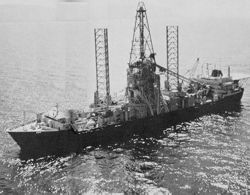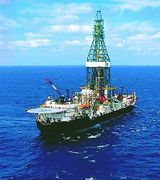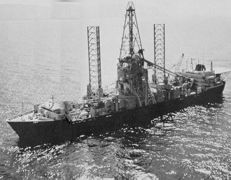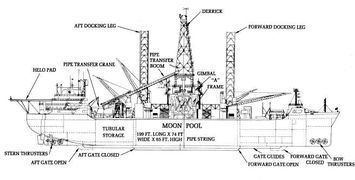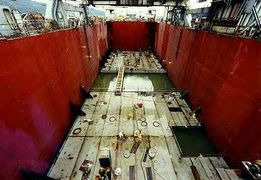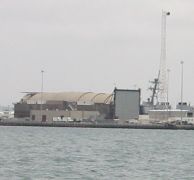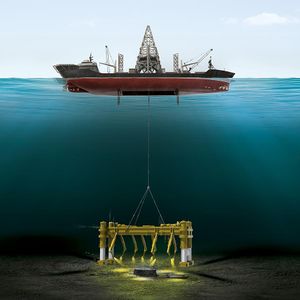Glomar Explorer
Hughes Glomar Explorer
On or about 11 April, 1968, a Soviet Golf-II class diesel-electric ballistic missile submarine, K-129, floundered and sank while on patrol in the Pacific Ocean. The cause of the submarine's failure remains unknown, though most speculation surrounds a missile malfunction of some kind. There are unsubstantiated reports that the USS Swordfish (SSN 579), an American submarine reportedly assigned to surveillance of K129, appeared in the Japanese port of Yokosuka requiring repairs for superficial damage, described variously as everything from a "bent periscope" to a "crumpled conning tower." The implication of these reports, and of occasional claims of the Soviet government, is that Swordfish collided with K129, and had a hand in its demise. This is a distinct possibility, given what has been revealed (notably in Blind Man's Bluff) about the unforgiving following distances and harrowing tactics of cold-war submariners. Whatever the cause of K129's destruction, it did not go quietly. K129's distress was detected by underwater listening posts (the SOSUS line), installed by the United States Navy and used to track the movement of Soviet warships. The Soviets, despite mounting a considerable effort, apparently failed in their efforts to locate the submarine. In a maneuver typical of cold-war politics, the US offered to assist the Soviets in locating their missing boat. Unsurprisingly, the Soviet government steadfastly refused to acknowledge the accident. No submarine had been lost, they said, and therefore no assistance would be required.
The Soviet Golf-II class was not a particularly cutting-edge submarine, even by 1968 standards. It was not nuclear powered, although it carried nuclear weaponry - three R-13 ballistic missiles as well as two nuclear-tipped torpedoes. It also carried something that all Soviet submarines carried, and something which had tremendous appeal to the American Central Intelligence Agency: cryptographic gear for transmitting and receiving encoded, secure communications. Recognizing a unique opportunity to study and reverse engineer Soviet weaponry and crypto gear, the CIA embarked on a bold and politically explosive plot to salvage the wreck of K129 from the ocean floor. The first step was finding the wreck.
K129 was located approximately 650 miles northwest of Hawaii by a US Navy Oceanic Research Vessel, USNS Mizar (AGOR 11), with assistance from a pair of specially modified 'research' submarines, USS Halibut (SSN 587) and USS Seawolf (SSN 575). Though locating the submarine took three naval crews a matter of weeks, it was the simplest part by far, for after losing her seaworthiness, K129 had plunged to a staggering depth of nearly 17000 feet (5200 m, or 3.2 miles). In 1968, no submarine had come close to submerging to such a depth, and no surface vessel existed with the ability to reach so far beneath the sea.
Enter Glomar Explorer. Displacing between 51000 and 63000 tons (varies according to source), 619 feet long, with a 116-foot beam, Glomar Explorer was built by Howard Hughes at the Sun Shipbuilding and Drydock Company. Ostensibly funded by Hughes, and built for his Deep Ocean Mining Project (DOMP) with the dubious purpose of mining manganese nodules from the deep sea bed, Glomar Explorer's $200 million price tag was almost certainly bankrolled at least in part by the CIA, and her raison d'etre had little to do with manganese nodules. Approved in absolute secrecy by Richard M. Nixon, as part of a highly classified CIA operation called Project Jennifer, she was purpose-built to salvage the wreck of K129.
Glomar Explorer was completed in 1973. The ship's interior contained a massive and highly secret hanger, with a 199-foot long "moon pool" - an open-water cutout, allowing the crew direct access to the water beneath the massive vessel. Along with Glomar Explorer, the Hughes Deep Ocean Mining Project constructed two additional components: a massive claw (dubbed "Clementine" by the crew of Glomar Explorer), intended to lift the 3000-ton hulk of K129 from the muck of the seabed, and the HMB-1 (Hughes Mining Barge 1), a huge submersible barge (actually a dry dock of sorts) designed to house the claw and the wreckage, once recovered. The HMB-1 would be carried in Glomar's interior hanger and lowered into the water through the moon pool. This arrangement allowed the operation to take place completely hidden from the prying eyes of spy satellites, reconnaissance aircraft, and Soviet trawlers.
Once HMB-1 was lowered into the water, Glomar Explorer would begin to assemble and spool out the 3.2 miles of tether attached to the massive claw, Clementine. The claw was to be lowered and raised so gradually that the round trip to the seafloor would take more than three days of travel. All told, the Glomar Explorer would spend more than a month on station executing its unique mission. Because it was nearly impossible to drop anchor in 17000 feet of water, Glomar Explorer utilized an elaborate and advanced technique for remaining motionless on the sea. Fitted with automatically-controlled, rotating vectored thrusters which allowed for careful repositioning and movement compensation, Glomar Explorer accessed a then top-secret set of global positioning satellites to navigate and position itself.
Like so much of the information surrounding Glomar Explorer and Project Jennifer, the results of the sea mission itself are classified, mired in argument, and obscured by wildly divergent accounts. Most agree that Glomar Explorer's claw successfully reached the seafloor and was able to grip and free the corpse of K129. Many versions insist that numerous attempts were made, but it is generally accepted that the submarine was liberated from the seafloor. What happened during the lift of K129 is unclear. Many sources report that an accident of some kind, possibly a stress fracture of the lifting claw, caused more than half of the submarine's hull to break off and fall back to the seafloor, never to be recovered. At least some portion of K129 was successfully recovered, including, according to most accounts, two nuclear-tipped torpedoes and the remains of six (or eight) Soviet sailors. Some report that as many as 70 bodies were recovered, and some believe that the entire submarine, complete with ICBMs, was recovered successfully. What is certain is that the CIA, in a strange and politically motivated gesture, returned the bodies of K129's sailors to the sea, with full Soviet Military honors, and videotaped the ceremony. This video was made public after it was presented by CIA director Robert Gates to Russian President Boris Yeltsin in 1992.
Glomar Explorer eventually caught the attention of the press. Some accounts report that in 1975 a bizarre double break-in of Hughes' offices resulted in Project Jennifer documents being stolen and leaked to the press. What is certain is that Harriet Ann Phillipi, a Los Angeles Times journalist, submitted a Freedom of Information Act request for CIA records of attempts to gag media investigations into the origins and purpose of Glomar Explorer. Her request was denied under exemption 1 of the FOIA, and the CIA issued, for the first time ever, the now oft-repeated declaration that it could "neither confirm nor deny" the existence of such records. This coinage became known as "Glomarization" or the "Glomar Response" among the American Press and Intelligence Community.
Glomar Explorer itself lived on after Project Jennifer ended. Transferred to US Navy ownership in 1976, the ship was designated T-AG 193, though it was still commonly referred to as Glomar Explorer. On 17 January 1977 T-AG 193 was transferred to Maritime Administration and mothballed at Suisun Bay, California. Unable to sell the ship, the Navy leased it to Global Marine Development for use as an offshore mining/drilling platform from 1978-1980. In 1980 it was again mothballed at Suisun Bay, where it remained until 1996. T-AG 193 was reconditioned and refitted in 1996, at an estimated cost of $180 million. In 1998 it resumed duty, again in the service of Global Marine, who currently holds a 30-year lease on the vessel.
HMB-1 was converted into a floating dry dock. There is some evidence that it was used as part of the Sea Shadow stealth ship project. It is believed that the HMB-1 is currently in storage, along with the Sea Shadow.
The final disposition of K129's salvage remains unknown. The United States government has never officially acknowledged the salvage operation of K129, and the Soviet government has never acknowledged its loss.
What links here • References and Sources • Help • Contact Info
